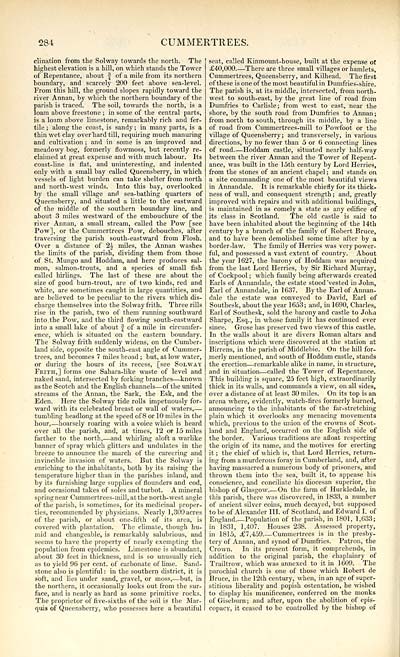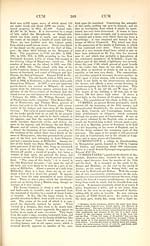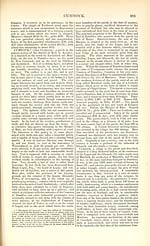Topographical, statistical, and historical gazetteer of Scotland > Volume 1
(366) Page 284
Download files
Complete book:
Individual page:
Thumbnail gallery: Grid view | List view

284
CUMMERTREES.
clination from the Solway towards the north. The
highest elevation is a hill, on which stands the Tower
of Repentance, ahout § of a mile from its northern
boundary, and scarcely 200 feet above sea-level.
From this hill, the ground slopes rapidly toward the
river Annan, by which the northern boundary of the
parish is traced. The soil, towards the north, is a
loam above freestone ; in some of the central parts,
is a loam above limestone, remarkably rich and fer-
tile ; along the coast, is sandy ; in many parts, is a
thin wet clay overliard till, requiring much manuring
and cultivation ; and in some is an improved and
meadowy bog, formerly flowmoss, but recently re-
claimed at great expense and with much labour. Its
coast-line is flat, and uninteresting, and indented
only with a small bay called Queensberry, in which
vessels of light burden can take shelter from north
and north-west winds. Into this bay, overlooked
by the small village and sea-bathing quarters of
Queensberry, and situated a little to the eastward
of the middle of the southern boundary line, and
about 3 miles westward of the embouchure of the
river Annan, a small stream, called the Pow [see
Pow], or the Cummertrees Pow, debouches, after
traversing the parish south-eastward from Flosh.
Over a distance of 2^ miles, the Annan washes
the limits of the parish, dividing them from those
of St. Mungo and Hoddam, and here produces sal-
mon, salmon-trouts, and a species of small fish
called hirlings. The last of these are about the
size of good burn-trout, are of two kinds, red and
white, are sometimes caught in large quantities, and
are believed to be peculiar to the rivers which dis-
charge themselves into the Solway frith. Three rills
rise in the parish, two of them running southward
into the Pow, and the third flowing south-eastward
into a small lake of about J of a mile in circumfer-
ence, which is situated on the eastern boundary.
The Solway frith suddenly widens, on the Cumber-
land side, opposite the south-east angle of Cummer-
trees, and becomes 7 miles broad ; but, at low water,
or during the hours of its recess, [see Solway
Frith,] forms one Sahara-like waste of level and
naked sand, intersected by forking branches — known
as the Scotch and the English channels — of the united
streams of the Annan, the Sark, the Esk, and the
Eden. Here the Solway tide rolls impetuously for-
ward with its celebrated breast or wall of waters, —
tumbling headlong at the speed of 8 or 10 miles in the
hour, — hoarsely roaring with a voice which is heard
over all the parish, and, at times, 12 or 15 miles
farther to the north, — and whirling aloft a warlike
banner of spray which glitters and undulates in the
breeze to announce the march of the careering and
invincible invasion of waters. But the Solway is
enriching to the inhabitants, both by its raising the
temperature higher than in the parishes inland, and
by its furnishing large supplies of flounders and cod,
and occasional takes of soles andturbot. A mineral
springnear Cummertrees-mill, at the north-west angle
of the parish, is sometimes, for its medicinal proper-
ties, recommended by physicians. Nearly 1,300 acres
of the parish, or about one-fifth of its area, is
covered with plantation. The climate, though hu-
mid and changeable, is remarkably salubrious, and
seems to have the property of nearly exempting the
population from epidemics. Limestone is abundant,
about 30 feet in thickness, and is so unusually rich
as to yield 96 per cent, of carbonate of lime. Sand-
stone also is plentiful : in the southern district, it is
soft, and lies under sand, gravel, or moss, — but, in
the northern, it occasionally looks out from the sur-
face, and is nearly as hard as some primitive rocks.
The proprietor of five-sixths of the soil is the Mar-
quis of Queensberry, who possesses here a beautiful
seat, called Kinmount-house, built at the expense ot
£40,000 There are three small villages or hamlets,
Cummertrees, Queensberry, and Kilhead. The first
of these is one of the most beautiful in Dumfries-shire.
The parish is, at its middle, intersected, from north-
west to south-east, by the great line of road from
Dumfries to Carlisle; from west to east, near the
shore, by the south road from Dumfries to Annan ;
from north to south, through its middle, by a line
of road from Cummertrees-mill to Powfoot or the
village of Queensberry ; and transversely, in various
directions, by no fewer than 5 or 6 connecting lines
of road. — Hoddam castle, situated nearly half-way
between the river Annan and the Tower of Repent-
ance, was built in the 15th century by Lord Herries,
from the stones of an ancient chapel ; and stands on
a site commanding one of the most beautiful views
in Annandale. It is remarkable chiefly for its thick-
ness of wall, and consequent strength ; and, greatly
improved with repairs and with additional buildings,
is maintained in as comely a state as any edifice of
its class in Scotland. The old castle is said to
have been inhabited about the beginning of the 14th
century by a branch of the family of Robert Bruce,
and to have been demolished some time after by a
border-law. The family of Herries was very power-
ful, and possessed a vast extent of country. About
the year 1627, the barony of Hoddam was acquired
from the last Lord Herries, by Sir Richard Murray,
of Cockpool ; which family being afterwards created
Earls of Annandale, the estate stood 'vested in John,
Earl of Annandale, in 1637. By the Earl of Annan-
dale the estate was conveyed to David, Earl of
Southesk, about the year 1653; and, in 1690, Charles,
Earl of Southesk, sold the barony and castle to John
Sharpe, Esq., in whose family it has continued ever
since. Grose has preserved two views of this castle.
In the walls about it are divers Roman altars and
inscriptions which were discovered at the station at
Birrens, in the parish of Middlebie. On the hill for-
merly mentioned, and south of Hoddam castle, stands
the erection — remarkable alike in name, in structure,
and in situation — called the Tower of Repentance.
This building is square, 2.5 feet high, extraordinarily
thick in its walls, and commands a view, on all sides,
over a distance of at least 30 miles. On its top is an
arena where, evidently, watch-fires formerly burned,
announcing to the inhabitants of the far-stretching
plain which it overlooks any menacing movements
which, previous to the union of the crowns of Scot-
land and England, occurred on the English side of
the border. Various traditions are afloat respecting
the origin of its name, and the motives for erecting
it ; the chief of which is, that Lord Herries, return-
ing from a murderous foray in Cumberland, and, after
having massacred a numerous body of prisoners, and
thrown them into the sea, built it, to appease his
conscience, and conciliate his diocesan superior, the
bishop of Glasgow. — On the farm of Hurkledale, in
this parish, there was discovered, in 1833, a number
of ancient silver coins, much decayed, but supposed
to be of Alexander III. of Scotland, and Edward I. of
England. — Population of the parish, in 1801, 1,633;
in 1831, 1,407. Houses 238. Assessed property,
in 1815, .£7,459.. — Cummertrees is in the presby-
tery of Annan, and synod of Dumfries. Patron, the
Crown. In its present form, it comprehends, in
addition to the original parish, the chaplainry of
Trailtrow, which was annexed to it in 1609. The
parochial church is one of those which Robert de
Bruce, in the 12th century, when, in an age of super-
stitious liberality and popish ostentation, he wished
to display his munificence, conferred on the monks
of Giseburn; and after, upon the abolition of epis-
copacy, it ceased to be controlled by the bishop of
CUMMERTREES.
clination from the Solway towards the north. The
highest elevation is a hill, on which stands the Tower
of Repentance, ahout § of a mile from its northern
boundary, and scarcely 200 feet above sea-level.
From this hill, the ground slopes rapidly toward the
river Annan, by which the northern boundary of the
parish is traced. The soil, towards the north, is a
loam above freestone ; in some of the central parts,
is a loam above limestone, remarkably rich and fer-
tile ; along the coast, is sandy ; in many parts, is a
thin wet clay overliard till, requiring much manuring
and cultivation ; and in some is an improved and
meadowy bog, formerly flowmoss, but recently re-
claimed at great expense and with much labour. Its
coast-line is flat, and uninteresting, and indented
only with a small bay called Queensberry, in which
vessels of light burden can take shelter from north
and north-west winds. Into this bay, overlooked
by the small village and sea-bathing quarters of
Queensberry, and situated a little to the eastward
of the middle of the southern boundary line, and
about 3 miles westward of the embouchure of the
river Annan, a small stream, called the Pow [see
Pow], or the Cummertrees Pow, debouches, after
traversing the parish south-eastward from Flosh.
Over a distance of 2^ miles, the Annan washes
the limits of the parish, dividing them from those
of St. Mungo and Hoddam, and here produces sal-
mon, salmon-trouts, and a species of small fish
called hirlings. The last of these are about the
size of good burn-trout, are of two kinds, red and
white, are sometimes caught in large quantities, and
are believed to be peculiar to the rivers which dis-
charge themselves into the Solway frith. Three rills
rise in the parish, two of them running southward
into the Pow, and the third flowing south-eastward
into a small lake of about J of a mile in circumfer-
ence, which is situated on the eastern boundary.
The Solway frith suddenly widens, on the Cumber-
land side, opposite the south-east angle of Cummer-
trees, and becomes 7 miles broad ; but, at low water,
or during the hours of its recess, [see Solway
Frith,] forms one Sahara-like waste of level and
naked sand, intersected by forking branches — known
as the Scotch and the English channels — of the united
streams of the Annan, the Sark, the Esk, and the
Eden. Here the Solway tide rolls impetuously for-
ward with its celebrated breast or wall of waters, —
tumbling headlong at the speed of 8 or 10 miles in the
hour, — hoarsely roaring with a voice which is heard
over all the parish, and, at times, 12 or 15 miles
farther to the north, — and whirling aloft a warlike
banner of spray which glitters and undulates in the
breeze to announce the march of the careering and
invincible invasion of waters. But the Solway is
enriching to the inhabitants, both by its raising the
temperature higher than in the parishes inland, and
by its furnishing large supplies of flounders and cod,
and occasional takes of soles andturbot. A mineral
springnear Cummertrees-mill, at the north-west angle
of the parish, is sometimes, for its medicinal proper-
ties, recommended by physicians. Nearly 1,300 acres
of the parish, or about one-fifth of its area, is
covered with plantation. The climate, though hu-
mid and changeable, is remarkably salubrious, and
seems to have the property of nearly exempting the
population from epidemics. Limestone is abundant,
about 30 feet in thickness, and is so unusually rich
as to yield 96 per cent, of carbonate of lime. Sand-
stone also is plentiful : in the southern district, it is
soft, and lies under sand, gravel, or moss, — but, in
the northern, it occasionally looks out from the sur-
face, and is nearly as hard as some primitive rocks.
The proprietor of five-sixths of the soil is the Mar-
quis of Queensberry, who possesses here a beautiful
seat, called Kinmount-house, built at the expense ot
£40,000 There are three small villages or hamlets,
Cummertrees, Queensberry, and Kilhead. The first
of these is one of the most beautiful in Dumfries-shire.
The parish is, at its middle, intersected, from north-
west to south-east, by the great line of road from
Dumfries to Carlisle; from west to east, near the
shore, by the south road from Dumfries to Annan ;
from north to south, through its middle, by a line
of road from Cummertrees-mill to Powfoot or the
village of Queensberry ; and transversely, in various
directions, by no fewer than 5 or 6 connecting lines
of road. — Hoddam castle, situated nearly half-way
between the river Annan and the Tower of Repent-
ance, was built in the 15th century by Lord Herries,
from the stones of an ancient chapel ; and stands on
a site commanding one of the most beautiful views
in Annandale. It is remarkable chiefly for its thick-
ness of wall, and consequent strength ; and, greatly
improved with repairs and with additional buildings,
is maintained in as comely a state as any edifice of
its class in Scotland. The old castle is said to
have been inhabited about the beginning of the 14th
century by a branch of the family of Robert Bruce,
and to have been demolished some time after by a
border-law. The family of Herries was very power-
ful, and possessed a vast extent of country. About
the year 1627, the barony of Hoddam was acquired
from the last Lord Herries, by Sir Richard Murray,
of Cockpool ; which family being afterwards created
Earls of Annandale, the estate stood 'vested in John,
Earl of Annandale, in 1637. By the Earl of Annan-
dale the estate was conveyed to David, Earl of
Southesk, about the year 1653; and, in 1690, Charles,
Earl of Southesk, sold the barony and castle to John
Sharpe, Esq., in whose family it has continued ever
since. Grose has preserved two views of this castle.
In the walls about it are divers Roman altars and
inscriptions which were discovered at the station at
Birrens, in the parish of Middlebie. On the hill for-
merly mentioned, and south of Hoddam castle, stands
the erection — remarkable alike in name, in structure,
and in situation — called the Tower of Repentance.
This building is square, 2.5 feet high, extraordinarily
thick in its walls, and commands a view, on all sides,
over a distance of at least 30 miles. On its top is an
arena where, evidently, watch-fires formerly burned,
announcing to the inhabitants of the far-stretching
plain which it overlooks any menacing movements
which, previous to the union of the crowns of Scot-
land and England, occurred on the English side of
the border. Various traditions are afloat respecting
the origin of its name, and the motives for erecting
it ; the chief of which is, that Lord Herries, return-
ing from a murderous foray in Cumberland, and, after
having massacred a numerous body of prisoners, and
thrown them into the sea, built it, to appease his
conscience, and conciliate his diocesan superior, the
bishop of Glasgow. — On the farm of Hurkledale, in
this parish, there was discovered, in 1833, a number
of ancient silver coins, much decayed, but supposed
to be of Alexander III. of Scotland, and Edward I. of
England. — Population of the parish, in 1801, 1,633;
in 1831, 1,407. Houses 238. Assessed property,
in 1815, .£7,459.. — Cummertrees is in the presby-
tery of Annan, and synod of Dumfries. Patron, the
Crown. In its present form, it comprehends, in
addition to the original parish, the chaplainry of
Trailtrow, which was annexed to it in 1609. The
parochial church is one of those which Robert de
Bruce, in the 12th century, when, in an age of super-
stitious liberality and popish ostentation, he wished
to display his munificence, conferred on the monks
of Giseburn; and after, upon the abolition of epis-
copacy, it ceased to be controlled by the bishop of
Set display mode to: Large image | Transcription
Images and transcriptions on this page, including medium image downloads, may be used under the Creative Commons Attribution 4.0 International Licence unless otherwise stated. ![]()
| Gazetteers of Scotland, 1803-1901 > Topographical, statistical, and historical gazetteer of Scotland > Volume 1 > (366) Page 284 |
|---|
| Permanent URL | https://digital.nls.uk/97441938 |
|---|
| Description | Volume first. A-H. |
|---|---|
| Attribution and copyright: |
|

